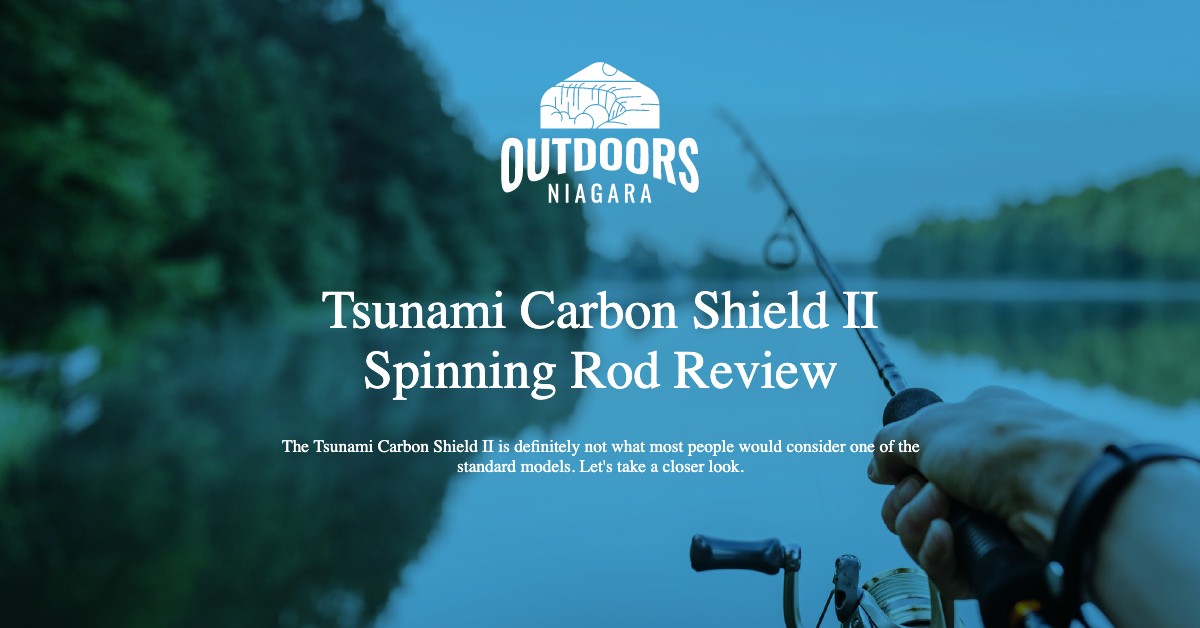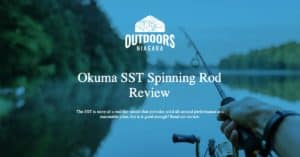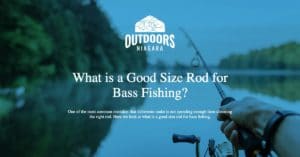The Tsunami Carbon Shield II is definitely not what most people would consider one of the “standard models” when talking about a versatile spin casting rod.
But that’s because, in a large part, the Tsunami features design choices more suitable for inshore and offshore fishing than it does freshwater fishing products.
That said, the Tsunami has a lightweight design that still manages to offer great durability and plenty of backbone at a fair price.
Of course, with something as specialized as saltwater fishing, it’s worth digging deeper to discover whether or not this will become one of your new favorite brands to help land your next big trophy fish.
Contents
Pros
- Light IM7 graphite
- Mostly durable build
- Extremely smooth casting
Cons
- Not the most affordable
- Not the most sensitive
- Not for freshwater fishing
Review
Construction (craftsmanship, make quality)
The carbon fiber construction of the Carbon Shield II spin casting rod seems fairly straightforward at first with fairly high-modulus IM7 graphite used for the blank.
However, this durable blank employs a D16 nanotech weave construction that significantly increases the strength and reliability of this high-quality blank with multidirectional fiber layups.
This design sees the fibers wrapped in eight different directions, affording additional strength from sixteen different axes to significantly increase hoop strength.
On top of that, the nano resin used to seal and stabilize the carbon-graphite fibers allows for a much tighter, denser weave and makes exceptionally resilient blanks.
Yet, the Tsunami inshore rod isn’t finished in terms of its uncommon design choices that also see the use of contoured split reel seats.
Aside from the fact that this profile lets the aluminum reel seat sit more comfortably in your hands and only produces minimal fatigue for your hands, it also allows for a speedy switch when changing out your spinning reels.
The ALPS Aluminum Oxide Guides aren’t necessarily the most advanced of the Carbon Shield II’s high-performance components, they still offer plenty of benefits.
For starters, the guide system employs single-footed guides to make replacing them much faster and easier while also reducing their weight and impact on the rod’s action.
While the Tsunami Carbon Shield II may not use traditional split grips, there is still a gap between the aluminum reel seat and the rear grip, giving you access to the rod blank for additional touch.
However, there is no such gap between the aluminum reel seat and the fore grip, so keep that in mind when considering sensitivity.
Material
Given that the Tsunami is meant to be used for inshore and offshore fishing, you might think that high-modulus IM7 carbon graphite is a bit on the flimsy side.
But, thanks to the sophisticated carbon fiber design, this approach produces feather-light fiber blanks that are comfortable for use during all-day fishing trips.
Even better, the nano resin that allows the carbon-graphite fibers to be woven so tightly also reduces the number of fibers necessary.
This combined with the D16 nano weave helps ensure that this lightweight spinning gear avoids snaps and cracks when fighting the feistiest of fish or even accidentally whacking the blank against a hard surface.
One area, however, where the Tsunami pole doesn’t use extremely lightweight materials is the anodized aluminum reel seat which is much heavier than the carbon fiber or nylon materials more commonly used.
That said, what the aluminum reel seat trades in weight it more than makes up for in durability.
Of course, you don’t have to worry about the weight of the ALPS Aluminum Oxide Guides on the Carbon Shield II spin-casting rod.
Aside from the fact that aluminum oxide ring guides are some of the lightest materials used for a pole’s guide system, they also impart several other important qualities to the rod’s overall functionality.
Finally, this spin pole provides premium cork grips, though they follow the full grip design with just a touch of the blank exposed.
While this approach may not be ideal for sensitivity, you don’t have to worry about all-day comfort or hand fatigue when using this spin caster, though the saltwater will cause pitting over time.
Action
Despite the whippy IM7 carbon-graphite fiber used, the Tsunami Carbon Shield II still managed to maintain a crisp carbon fiber action.
That said, you don’t get many options to choose from when it comes to this pole’s action as it only comes in fast action. While this approach may somewhat temper your casting distance, it significantly increases your casting accuracy.
If you do your inshore fishing on the West Coast or the Caribbean, the boost to casting control the fast action affords will help you land your lure right in the middle of a big school.
On top of that, the fast action also provides the bonus of increasing the sensitivity of the pole– something that it definitely benefits from more than some of its competition.
Power
The Tsunami rod may not boast the widest power rating range on the market, but it comes in models that start at a medium-light power rating and run to medium-heavy.
That said, the Carbon Shield II also comes in an XH version, but this power rating only shows up with the slow pitch models made for power fishing.
For most purposes (and fishermen) topping out at a medium-heavy power rating should be more than enough backbone– even when going after those larger fish with plenty of fight.
However, this pole works equally well with even some of the smaller inshore species thanks to the medium-light power rating and the blank’s ability to perform finesse techniques.
Rod Guides
The ALPS Tangle Free Aluminum-Oxide Guides, as their name suggests, are some of the smoothest guides out there and significantly reduce how much time you have to untangle your fishing line.
However, the ALPS Aluminum Oxide Guides take things a step further by also being able to handle braided lines– which are almost a must with saltwater fishing.
That said, these aluminum guides will still show their limits with the biggest trophy fish– like when using braid for snook fishing.
While you won’t see as much issue with the guides along the rod blank, you might eventually have to contend with a braided fishing line cutting a groove into the tip guide, so keep a repair kit handy.
Handle (material, shape, etc)
When you consider some of the other saltwater design choices, the absence of EVA foam grips in favor of a cork grip for both the fore grip and rear grip is a relief.
Granted, it would be nice to see a bit more exposed blank for the bump in sensitivity, but you won’t have to worry about the grips coming apart anytime soon either.
Keep in mind that when fighting the biggest fish inshore or offshore, the additional leverage the full grip handle affords will feel invaluable– especially if you’re not using a net.
It also doesn’t hurt that the cork makes for a comfortable grip.
Uses (Who is this good for)
While a light-tackle technique may seem a bit unexpected outside of the West Coast, the Tsunami is a more than capable finesse technique spinning pole that allows you to handle when the fish dive for safety and if they’re in brush or underwater vegetation.
This works especially well for offshore tuna that often don’t have anywhere to hide.
With a solid knowledge of tarpon fishing tactics, you can even turn the Carbon Shield II into a kayak tarpon rod, perfect for targeting migratory tarpon and able to handle the biggest fish fighting.
Caribbean fishermen fishing for snook should also appreciate the surprising amount of strength and plenty of backbone afforded by this spinning pole.
One thing to consider is that this rod comes in a green color, though it’s probably more accurate to say that it is seafoam in color.
While this has virtually no impact on the performance of this versatile spinning rod, it is something that not all fishermen will want.
On the other hand, it’s also a nice change of pace from the standard black.
Reel and Real Seat Compatibility
Because the Tsunami spinning pole is designed for use in saltwater applications, it uses an anodized aluminum reel seat with stainless steel hoods custom locking ring.
For the uninitiated, this may not seem like a big difference, but neither of those metals transfers vibration nearly as well as graphite carbon fiber.
That said, the custom aluminum reel seat almost needs to use these metals to help avoid damage done by the corrosive saltwater– though, you’ll still need to keep them cleaned with regular maintenance.
On the other hand, it will be pretty difficult to find an option more durable than an aluminum reel seat, let alone the stainless steel hoods.
Conclusion (Wrap Up)
Because this fishing gear investment doesn’t come at a true budget-friendly price, it can be a bit difficult to determine whether or not it’s right for you– even if it’s still a relatively affordable option.
However, as a finesse technique spinning rod, the Carbon Shield II performs admirably well with a crisp action on an otherwise flexible blank.
Thankfully, you don’t need to worry about that flexibility impacting the strength of the rod as the D16 nano weave provides plenty of backbone to go along with its bend.
Of course, when you then add the incredibly durable aluminum reel seat, stainless steel hoods, and even the aluminum oxide guides on top of that, you shouldn’t have any concerns about whether or not this rod can handle multiple seasons of hard fishing.







